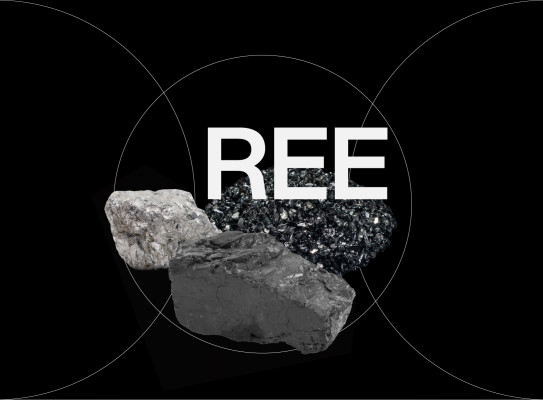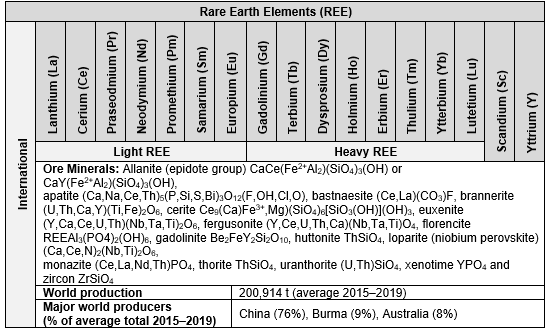Rare Earth Elements (REEs)

Rare Earth Elements (REEs) are a group of 17 chemically similar elements, including the 15 lanthanides, plus associated elements scandium (Sc) and yttrium (Y). Despite their name, REEs are relatively abundant in the Earth’s crust but rarely found in economically viable concentrations. They are essential for modern technology, clean energy, and advanced materials, making them a focus for exploration geologists.
Rare Earth Elements in New Zealand
Monazite (Ce,La )PO₄, xenotime YPO₄ and allanite (Ca,REE)₂(Al,Fe)₃(SiO₄)₃(OH) – the most widespread primary REE-bearing minerals – occur as trace minerals in some granites, pegmatites and gneisses and are concentrated in placer deposits derived from these source rocks. The main occurrences are in heavy mineral-rich beach placers in northwest Nelson, Westland and Southland and at Port Pegasus on Rakiura / Stewart Island. REEs are also associated with carbonatite dikes and alkaline intrusive rocks in the South Island. Anomalous concentrations of REEs have been found in halloysite clays produced by weathering of Late Miocene–Pliocene alkaline rhyolite domes in Northland.
New Zealand hosts several types of REE mineralisation associated with different geological settings:
-
Carbonatite-Hosted REE Deposits
- Found in lamprophyre intrusions within Haast Schist (South Westland, northwest Otago) and in the mafic-ultramafic Tapuaenuku Igneous Complex (Marlborough).
- REE-bearing minerals include monazite, thorite, apatite, rutile, aegirine, albite, pyrite, sphalerite, and galena.
- Some of the highest recorded REE concentrations are from the Haast River carbonatites (up to 12,560 ppm La+Ce+Y).
-
Alkali Complex-Hosted REE Deposits
- Associated with peralkaline and alkaline igneous intrusions in West Coast, Fiordland, Canterbury, northwest Nelson, and Marlborough.
- REEs occur in bastnäsite group, allanite, zircon, fergusonite, xenotime, monazite, florencite, perrierite-loparite and fluorapatite.
- French Creek Granite (600 ppm REE) and Sams Creek (719 ppm REE) are notable.
-
REE-Bearing Monazite in Granitic & Metamorphic Rocks
- Monazite (± xenotime) is a common accessory mineral in South Island granitoid rocks, particularly in Foulwind and French Creek granites.
- Some granites contain up to 0.042 wt% monazite (Cape Foulwind).
-
REE Associated with the Paparoa Metamorphic Core Complex
- Occur in the Paparoa Range and are linked to hydrothermal alteration along crustal-scale detachment faults that were active during a previous extensional tectonic regime.
- Elevated REE concentrations are reported in stream sediments.
-
Clay-Bearing REE Deposits
- Ion-adsorption type deposits occur in Northland (Kerikeri Volcanic Group) with halloysite clays from weathered alkaline rhyolite hosting REEs.
- Matauri Bay (678 ppm La+Ce+Y) and other sites show potential for low-cost REE extraction.
-
Placer REE Deposits
- Detrital monazite and xenotime are found in West Coast, Fiordland, Stewart Island, Southland and northwest Nelson heavy mineral beach sands and alluvial deposits.
- Allanite is a significant REE-bearing mineral in Westland sands, potentially a by-product of garnet mining (up to 0.83 vol%).
- Barrytown and Westport have the highest monazite concentrations (up to 0.12 vol%).
Why REEs are Important
Essential for Advanced and Renewable Technologies
- Magnets: Neodymium (Nd), praseodymium (Pr), dysprosium (Dy), samarium (Sm) and terbium (Tb) are key in high-strength permanent magnets used in wind turbines, electric vehicles (EVs), and defence applications.
- Batteries and energy storage: Lanthanum (La) and cerium (Ce) are used in nickel-metal hydride (NiMH) batteries and potential new battery technologies.
- Catalysts: Ce and La are widely used in automotive catalytic converters, improving air quality by reducing emissions.
Critical for Electronics and Communication
- Smartphones, laptops, and displays: Europium (Eu), terbium (Tb), neodymium (Nd), praseodymium (Pr) and yttrium (Y) are used in LEDs, fluorescent lighting, and display screens.
- Fibre optics and communication: Er, Nd, ytterbium (Yb) and thulium (Tm) are essential in fibre optic amplifiers, enabling high-speed internet.
Medical and Industrial Applications
- MRI contrast agents: Gadolinium (Gd) is used in medical imaging for high-resolution MRI scans.
- Alloys and metallurgy: REEs improve the strength and heat resistance of metals used in aerospace, defence, and nuclear reactors.

Geological Occurrence and Deposit Types
REEs are hosted in a variety of geological settings, with key deposit types including carbonatites, alkaline igneous complexes, lateritic deposits, ion-adsorption clays, and placer deposits.
-
Carbonatite-Hosted REE Deposits
Carbonatites are igneous rocks, and related hydrothermal alteration, rich in carbonate minerals, and are often associated with the mantle-derived magmatism typical of intracontinental rift settings.
REEs are commonly hosted in minerals such as:
- Bastnäsite group ((Ce,La,Y)CO₃F) – A primary source of light REEs (LREEs).
- Monazite ((Ce,La)PO₄) – Contains both LREEs and thorium (radioactive).
- Ancylite ((Sr,Ca,Ce,La)(CO₃)₂(OH)·H₂O) – Occurs in some deposits.
- Xenotime (YPO₄).
- (Fluor)apatite (Ca₅(PO₄)₃(F,Cl,OH)).
- Florencite ((Ce,La)Al₃(PO₄)₂(OH)₆) – found in carbonatites and associated hydrothermal alteration.
- Pyrochlore ((Na,Ca,REE,U)₂Nb₂O₆(OH,F)) – Found in carbonatites and associated alkaline complexes.
- Allanite ((Ca,REE)₂(Al,Fe)₃(SiO₄)₃(OH)) – typical of carbonatites and associated rocks.
Key Deposits:- Bayan Obo (China) – The world’s largest REE deposit, hosted in a carbonatite-iron ore complex.
- Mountain Pass (USA) – A bastnäsite-rich deposit supplying LREEs.
- Araxa (Brazil) and Kola Peninsula (Russia) – Major sources of REEs in carbonatite systems.
-
Alkaline Igneous Complexes
Alkaline rocks and peralkaline granites can host substantial REEs in pegmatites and hydrothermal veins and are typically associated with partial melting of an enriched, often mantle-derived source in late- to an-orogenic or intracontinental rift settings.
REEs are commonly found in minerals such as:- Eudialyte (Na₄(Ca,Ce)₂(Fe²⁺,Mn,Y)ZrSi₈O₂₂(OH,Cl)₂) – Hosts zirconium and heavy REEs (HREEs).
- Pyrochlore ((Na,Ca,REE,U)₂Nb₂O₆(OH,F)) – Found in REE-rich alkaline complexes.
- Bastnäsite group ((Ce,La,Y)CO₃F) – A primary source of light REEs (LREEs).
- Gadolinite ((Ce,La,Nd,Y)₂(Fe²⁺Be₂Si₂O₁₀) – typical of alkaline rocks and associated hydrothermal alteration.
- Loparite ((REE,Na,Ca)(Ti,Nb,Ta)O₃) – common in alkaline to peralkaline igneous rocks.
- Allanite ((Ca,REE)₂(Al,Fe)₃(SiO₄)₃(OH)) – typical of alkaline rocks and associated hydrothermal alteration.
- Fergusonite ((Ce,Nd,Y)NbO₄) – hydrothermal alteration associated with alkaline complexes.
Key Deposits:- Ilímaussaq (Greenland) – One of the largest eudialyte-hosted REE resources.
- Kringlerne (Greenland) and Lovozero (Russia) – Peralkaline-hosted deposits with significant HREE potential.
- Strange Lake (Canada) – globally significant deposit of both HREEs and LREEs hosted within a peralkaline granite and related pegmatites and aplites.
-
Lateritic REE Deposits
Formed by intense chemical weathering of REE-rich rocks (often carbonatites), concentrating mainly LREEs in residual clays and laterites. They are typically found in tropical regions with high rainfall and prolonged chemical weathering. Aggressive acid leaching (e.g., sulphuric acid) is required to extract LREEs from resistant minerals.
REEs are commonly found in minerals such as:
- Monazite
- Apatite
- Pyrochlore
- Crandallite group
- Bastnäsite group
- Churchite
- Rhabdophane
- Plumbogummite
- Florencite
- Xenotime
- Cerianite
Key Deposits:
- Mount Weld (Australia) – A laterite-hosted LREE deposit derived from weathered carbonatite.
- Tantalus (Tanzania) – A lateritic REE deposit with economic potential.
- Dong Pao (Vietnam) – A deeply weathered laterite deposit within syenite rocks and associated hydrothermal alteration.
-
Ion-Adsorption Clay Deposits (HREE-Rich)
Formed by partial chemical weathering of granite and REE-bearing minerals, leading to adsorption of REEs onto clay minerals. These deposits are important sources of HREEs, including Dy, Tb, and Y. REEs can be extracted using simple ionic exchange with ammonium sulphate or weak acid solutions, without aggressive leaching.
REEs are commonly found in minerals such as:
- Kaolinite (Al₂Si₂O₅(OH)₄) – Often in the form of halloysite.
Key Deposits:
- Southern China (Jiangxi, Guangdong, Guangxi Provinces) – The world’s dominant source of HREEs, extracted via simple leaching.
- Myanmar – An emerging source of ion-adsorption REEs.
- Kaolinite (Al₂Si₂O₅(OH)₄) – Often in the form of halloysite.
-
Placer and Monazite Sand Deposits
REE-rich minerals, particularly monazite and xenotime, can accumulate in coastal and alluvial heavy mineral placer deposits through weathering and sedimentary processes. They are historically important sources of REEs, though are declining due to radioactive thorium content.
Key Deposits:
- India (Kerala), Brazil, and South Africa – Rich in monazite sands.
- Madagascar – Hosts modern placer REE exploration.
Economic and Exploration Considerations
Rare Earth Elements are vital to modern life, with applications in technology, clean energy, and defence. Their diverse geological settings, complex extraction processes, and supply chain vulnerabilities make REE exploration a strategic priority for geologists and policymakers alike.
Supply Chain Challenges
- China dominates REE production, controlling >60% of global output, almost 90% of global processing capacity and most HREE supply.
- Geopolitical concerns have driven efforts to diversify supply, leading to increased exploration in the USA, Australia, and Africa.
Environmental and Processing Challenges
- Radioactive waste (from thorium and uranium) complicates mining and refining, requiring strict regulations.
- Processing REE ores requires complex hydrometallurgical techniques, often involving solvent extraction and ion exchange.
Future Exploration and Alternative Sources
Increased interest in:
- Off-shore REE deposits (e.g., Pacific Ocean muds and seafloor nodules).
- REE extraction from, for example, coal byproducts and phosphorites.
- Better REE recycling from, for example, electronic waste.
Additional Reading
Christie AB, Timm C, Rattenbury MS, Tulloch AJ. 2011. Rare earth element prospectivity stage 1. Lower Hutt (NZ): GNS Science. 29 p. (GNS Science consultancy report; 2011/49).
Cooper AF, Paterson LA. 2008. Carbonatites from a lamprophyric dyke-swarm, South Westland, New Zealand. Canadian Mineralogist. 46(4):753–777. https://doi.org/10.3749/canmin.46.4.753(external link)
Morgenstern R, Turnbull RE, Hill MP, Durance PMJ, Rattenbury MS. 2018. Rare earth element mineral potential in New Zealand. Lower Hutt (NZ): GNS Science. 211 p. Consultancy Report 2018/23. Prepared for New Zealand Petroleum and Minerals.
Download here with Realme login(external link)